
- On this Page:
- Content
- Using Youtube TV
- Features & Quality
- Platforms
- Value
- Our Verdict
YouTube TV is changing, in both good and bad ways. While YouTube TV’s channel lineup is expanding, its price has steadily been increasing as well. In this review, I remembered why I was so impressed with it in the first place: It’s an impressive and well-rounded live TV solution. It may eat into your savings a bit, but it also makes it painless to make the cord-cutting jump in the first place. That all said, let’s take a closer look at YouTube TV together in this review.
YouTube TV Pros and Cons
Pros
- One of the most complete channel lineups in live TV streaming
- 1080p streaming available for some platforms and channels
- Simple and smart menus and organization
- Impressive DVR features
Cons
- Loading issues sometimes interrupt streaming.
- Comprehensive live TV coverage doesn’t come cheap.
- It can’t always match the competition in regional sports network (RSN) coverage.
5 Reasons to Choose YouTube TV
- You want live TV with no contract.
- You’re looking to save more money than you would with cable.
- You’re looking for a simple, user-friendly approach.
- You don’t care about regional sports networks. (YouTube TV has recently lost a few!)
- You’re a fan of Alphabet (Google) and its products.
What You Can Watch on YouTube TV
There’s one thing we should get out of the way right off: YouTube TV is not the same thing as regular YouTube. Alphabet has used the YouTube brand for this service, and there are some limited YouTube connections to be found here (like the fact that YouTube Originals are available on YouTube TV), but YouTube TV is ultimately a fundamentally different service from YouTube. On YouTube, you can watch cat videos (and also CordCutting.com videos!); on YouTube TV, you can watch live TV channels in pretty much the same way you would with cable or satellite.
I approached YouTube TV expecting the same sorts of channels as I got with its competitors, like fuboTV and Sling TV, and I was very pleased. YouTube TV has all of my old cable-TV favorites, including AMC, ESPN, and HGTV.
And, unlike some of its biggest competitors, YouTube TV doesn’t have any obvious holes in its national channel lineup. Some live TV streaming services are missing Viacom channels — like Comedy Central, MTV, and VH1 — but YouTube TV isn’t. Other competitors are missing Turner networks — like CNN and TBS — but YouTube TV isn’t. Others are missing local feeds of the major networks (ABC, CBS, Fox, and NBC) in most markets, but YouTube TV isn’t.
All of this means that YouTube TV has a channel lineup that looks an awful lot like those of its competitors, but with slight differences that just about always favor YouTube TV. To be fair, most competitors have only small holes in their channel lineups (few services are missing Viacom networks, Turner networks, and the major networks), but YouTube TV has virtually no omissions. I was pretty darn impressed by this.
As of this writing, YouTube TV’s channel count stands at more than 100. That compares favorably with its competitors, though it’s worth noting that fuboTV and DIRECTV both offer more channels than YouTube TV. In terms of familiar fan-favorite networks, however, YouTube TV feels as complete as any of its competitors.
I review a lot of these services, so I have a lot of live TV apps on my devices. I’ve grown used to hopping from service to service depending on what I want to watch. For example, I might watch CBS on fuboTV for a while and then switch to Sling TV to watch CNN, because Sling TV doesn’t have CBS and fuboTV doesn’t have CNN. But YouTube TV has both, and as I worked on this review, I found myself using YouTube TV more and more often even after I finished work for the day. It was just easier to use YouTube TV because I didn’t have to worry about which channels I could watch on which service; YouTube TV seemed to have them all. More than most of its competitors, YouTube TV is a “one-stop shop” for live TV.
There’s one major caveat to this, though, and that’s sports — specifically, regional sports. Regional sports networks (RSNs) are the sorts of channels that are home to your local baseball, hockey, and basketball teams. You know the type: We’re talking about channels like NBC Sports Bay Area, Fox Sports Midwest, and so on.
YouTube TV’s primary problem is that, as of this writing, it’s missing some key RSNs. YouTube TV has a history of losing out on the Bally Sports (formerly Fox Sports) channels, and it’s also missing some well-known individual RSNs, like New York’s YES and SNY.
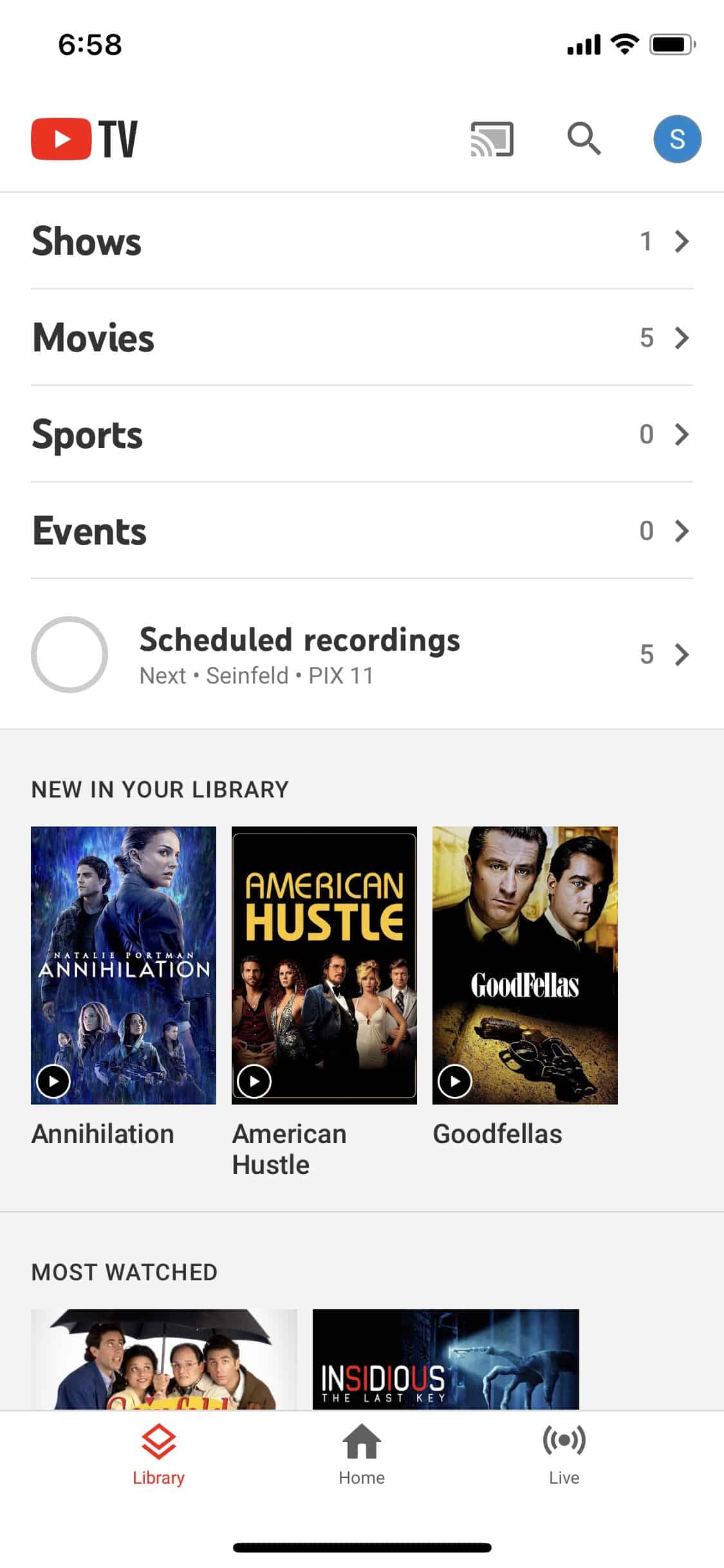
YouTube TV’s live TV is by far the best reason to subscribe to the service, but — like other live TV streaming services — it also offers on-demand content. Just like a lot of other services I’ve reviewed, YouTube TV seems to rely on recently aired content for its free on-demand content. I think this sort of on-demand content is a great perk, but don’t confuse it for a true on-demand library of the sort you’d find on a service like Netflix. Since YouTube TV is grabbing content from TV channels, its free on-demand library delivers the edited-for-TV versions of movies, not the theatrical versions.
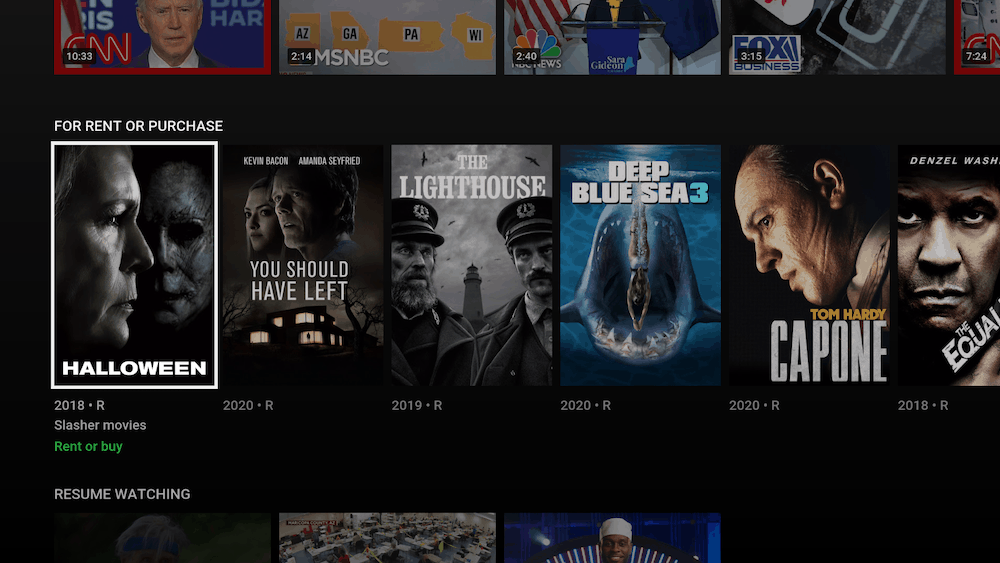
If you do want to watch the uncut versions of movies, YouTube TV has a solution for that: The service also includes access to movie rentals and purchases from YouTube. I’m not inclined to give YouTube TV a ton of credit for this, since I could just as easily watch fuboTV or Sling TV and then go pay for rentals and purchases on Amazon, iTunes, or Vudu. Still, I suppose it’s nice to have both the live TV option and the video rental marketplace in one app.

Finally, I should mention the YouTube Originals. These on-demand original series and movies are one of the few areas where YouTube TV seems connected to the “regular” YouTube brand. I watched a handful of episodes and portions of a couple of movies while testing this service, and I was reasonably impressed. Some of the YouTube originals wouldn’t look too out of place on regular old (free) YouTube. The episode of “BookTube” that I watched, for example, featured a podcast-style remote video interview and discussion. Only the production quality kept it from feeling like typical YouTube fare (which, to be clear, I don’t think is a bad thing — I watch a fair bit of YouTube myself).
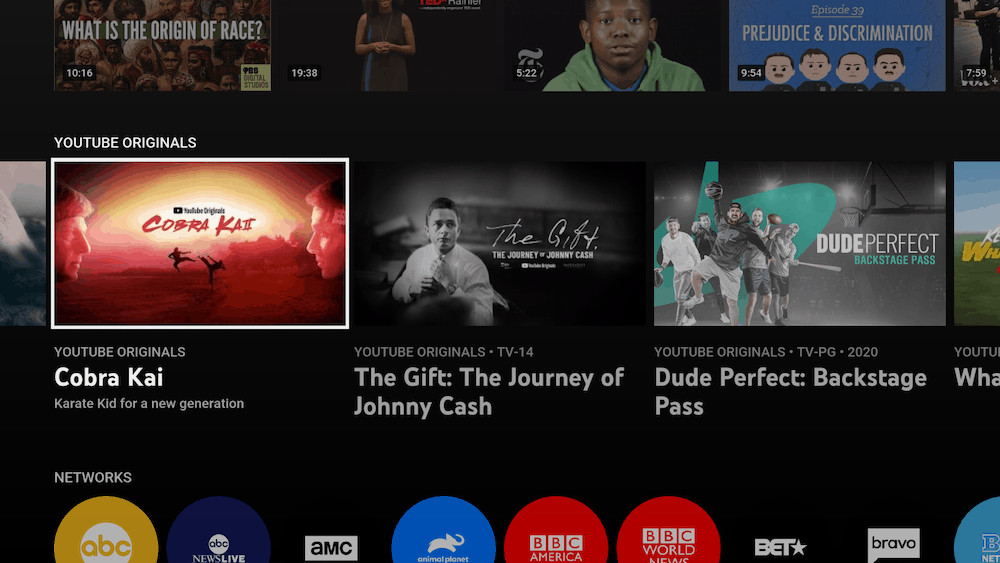
Other YouTube originals felt more like “regular” films. I felt that the documentary and discussion-style pieces tended to work better, largely because the low production budgets were far less noticeable than with the dramas and comedies. Of the originals I saw, my favorite was “The Gift: The Journey of Johnny Cash,” a biographical documentary of the country music legend that was both straightforward (think PBS or Ken Burns, not “Rolling Thunder Revue“) and very moving.
Based on the handful of episodes and movies I watched, my takeaway was that these extra on-demand options were pleasant additions but not game changers. In my view, they certainly didn’t measure up to the on-demand originals offered by competitor Hulu (Hulu’s live TV streaming subscription, Hulu + Live TV, includes the regular on-demand version of Hulu and all of the Hulu originals); there’s nothing here as good as “Palm Springs” (2020) or “The Handmaid’s Tale.” Still, I think the YouTube originals added something to YouTube TV — a little something, but something nonetheless.
How It Felt to Use YouTube TV
I was very impressed by the YouTube TV user experience. Of all of the services I’ve tried, YouTube TV has arguably the best and most straightforward system for organizing content. It’s a minimalist approach, and it has its downsides; there weren’t too many ways to sort and sift through content myself on the app’s home screen (though there were some buttons for categories on the web app if I scrolled down enough), so my on-demand content discovery was largely left up to YouTube TV’s choices of categories and mini-menus. But YouTube’s choices and groupings were pretty intuitive; I usually didn’t have to scroll far to find favorite shows, previously watched favorites, or live sports options.
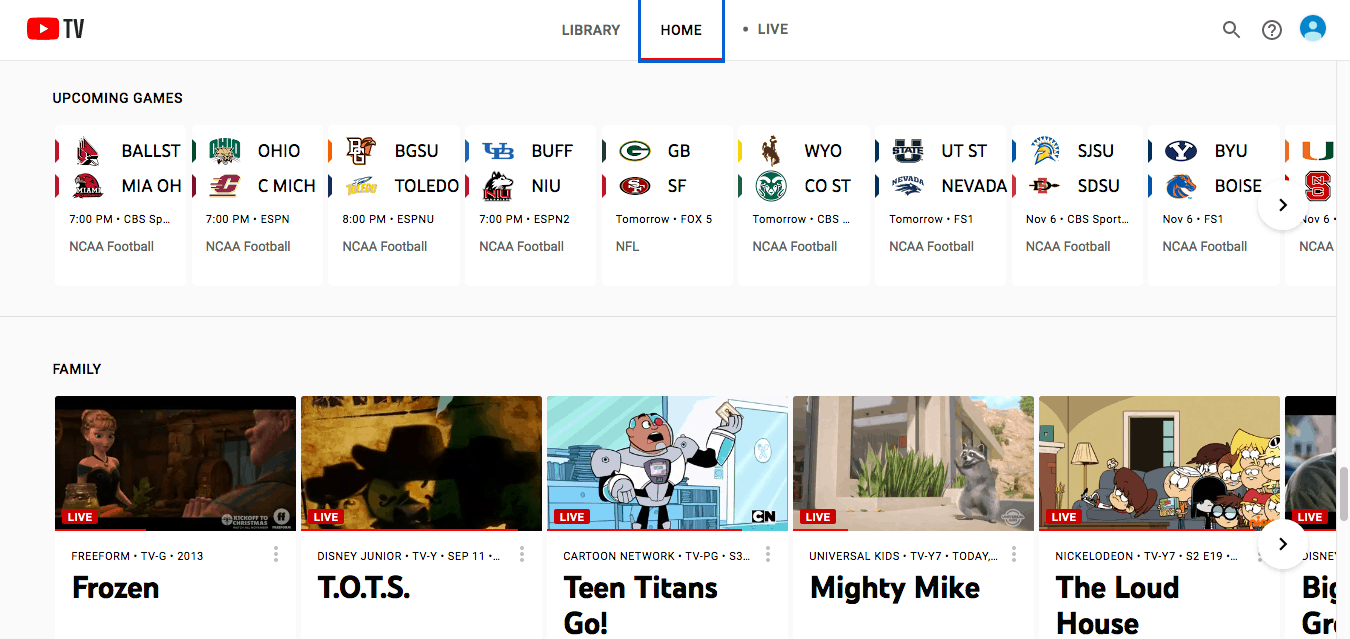
And when I did want to take a bit more control, that wasn’t too tough to do. The sorting options that were largely missing from the home screen were readily available on the “Live” tab, which worked like a TV guide. It was easy to slim down the TV guide’s list to just news or sports programming, and selecting things to watch or record was a breeze.

Speaking of recording programs, YouTube TV offered a really nice cloud DVR feature. As always with cloud DVRs, this feature lived online. My recordings weren’t saved online, so I could stream them from any device (even if I didn’t use that device to schedule the recording). As with plenty of other services like this, YouTube TV only barely pretends its cloud DVR is really a DVR. When I selected previously aired programs to “record,” they were instantly added to my watchlist (since there was no actual recording going on, I didn’t have to wait for reruns to air). In this sense, the DVR behaves more like a bookmark system for on-demand content.
There’s a flip side of this, though: If a cloud DVR “recording” is actually just a bookmark on a piece of on-demand content, what does that mean when the content leaves YouTube TV’s platform? There’s good news on this front: YouTube TV saves cloud DVR “recordings” to your library for up to nine months. I was really impressed by this. Some other services that take YouTube TV’s watchlist-style approach to cloud DVRs were quicker to throw out my recordings. On Philo, for example, my saved shows and movies were deleted after 30 days. YouTube TV’s approach was really the best of both worlds because it gave me Philo-style access to unlimited recordings but allowed me to keep my shows for longer, almost as if I’d really acquired a “recording” that was separate from YouTube TV’s on-demand catalog.
YouTube TV’s login system might be the only thing about it that I didn’t find totally intuitive. YouTube TV uses your Google account as a login, which makes sense; Google wants as much as possible in its ecosystem, after all. But this also means that you’re using a Gmail account, which might not be everyone’s cup of tea. I use my Gmail account professionally, and I don’t necessarily want to be logging in to smart TVs and Rokus with the same credentials that I use to access my work files. It also makes sharing login information with friends and family a little difficult, though Google has a workaround for this that I’ll talk about in the next section. All in all, I think this is a pretty minor complaint. It’s not all that tough to just create a new Google account if you’d rather keep your YouTube TV login separate (That’s what I did).
There was one missed opportunity here, in my opinion: YouTube TV doesn’t seem like a perfect use of the YouTube brand. I’m a big fan of YouTube (you know, the regular one), and I have the YouTube app on a lot of my devices. I found myself selecting the wrong YouTube icon surprisingly often, loading YouTube TV when I wanted YouTube, and vice versa. It was a silly little problem, but it kept reminding me that these two services share a name and not much else. Other than the YouTube original series and movies, there wasn’t much connecting the YouTube experience to the YouTube TV experience. I certainly couldn’t hop seamlessly between cat videos and live TV. Maybe Google doesn’t think there are many people who want to do that, but there’s at least one: me!
YouTube TV Features and Streaming Quality
YouTube TV offers some nice quality-of-life features. I already praised the DVR in this YouTube TV review, but let me say it again: I loved YouTube TV’s take on the cloud DVR. YouTube TV gave me the best of the cloud-style DVR by treating my recordings more like bookmarks or a watchlist (I could record as much as I wanted because I wasn’t really recording anything at all) without giving me the downsides, like short-term limits on saved content.
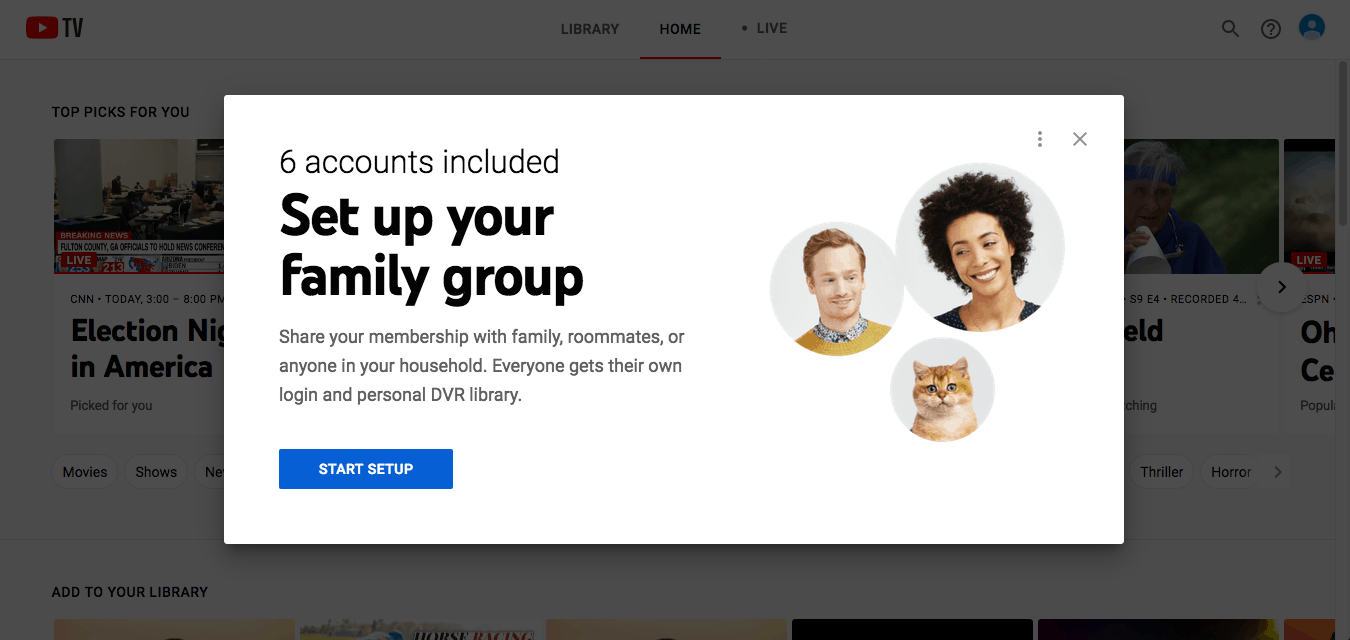
YouTube TV also had subscription-sharing options for use within a household. I consider this to be a pretty important feature for YouTube TV in particular, because the service is set up with a Google account, and most of us aren’t super keen on sharing our Gmail passwords with family members or roommates. Happily, it’s pretty easy to add other members to your virtual household. Connected accounts can log on with their own credentials and access the YouTube TV service that you pay for through your account — no password-sharing required.
Let’s talk about picture quality. I’m used to getting a certain level of picture quality out of a live TV streaming service, but YouTube TV exceeded my expectations. Most services like this top out at 720p HD. That’s the sort of “high definition” picture that might have excited me back in 2005, but it has long since been beaten by 1080p HD and, more recently, 4K Ultra HD (the numbers in these terms refer to the number of pixels on the screen: 720p and 1080p have 720 and 1080 rows of pixels down the side of the screen, respectively, while 4K UHD has roughly that many columns of pixels across the width of the screen).
The 720p HD norm makes sense because these services already have to move a lot of data very quickly in order to stream live TV. A service like fuboTV doesn’t have the luxury of preloading lots of data about a video stream the way that Netflix would. You can’t buffer out five minutes ahead on a live TV stream unless you have a time machine!
Somehow, YouTube TV seems immune to the limitations of live TV streaming. Unlike its competitors, it offers 1080p HD streaming. This picture quality isn’t available on every channel or on every device, but the fact that it exists at all is really impressive. I’ve never considered the 720p norm a deal-breaker for live TV streaming, but I was nevertheless thrilled to get the 1080p quality instead.
Picture quality is important, but it’s not the only factor in great streaming. Frame rate matters too. YouTube TV does pretty well here too, thanks to its 60 fps (frames per second) frame rate. That’s more or less the industry standard, though not every streaming service can match it. Having 60 fps is key for watching things like sports, where fewer frames would look more noticeably choppy.
At its 1080p and 60 fps best, YouTube TV was a joy to watch. But I didn’t find the service to be complete without streaming issues. In my trials, my YouTube TV feed occasionally cut out for a moment — presumably to catch up with its buffering — before starting again where it had left off. You won’t miss anything when interrupted like this (the feed is briefly frozen, not playing “behind the scenes” while you miss it), and these incidents were relatively rare (once every few hours or so), but I’d obviously have preferred not to have encountered this issue at all.
Another thing that’s important to remember with services like this is that they operate on a delay. I mentioned earlier that live TV streaming services can’t buffer as much as on-demand services can because the next five minutes of video quite literally don’t exist yet when the feed is live. But these services can buy themselves a bit of breathing room by running on a short delay. This can have minor consequences — for example, I was chatting with my Dad while watching Monday Night Football, and I heard him react to a touchdown before the play even started on my screen.
By and large, this sort of thing comes with the live TV streaming territory, but my testing did find that YouTube TV’s streaming delay was typically a few seconds longer than the delays on fuboTV and Sling TV. There’s a lot of variance at play here (for example, high-traffic times for internet might result in a longer delay), so I don’t assume that my findings are strictly scientific, but they do pass the common-sense test: A longer delay would make sense given that YouTube TV needs to move more data in order to deliver the 1080p HD feed, whereas its competitors are dealing only with 720p streaming.
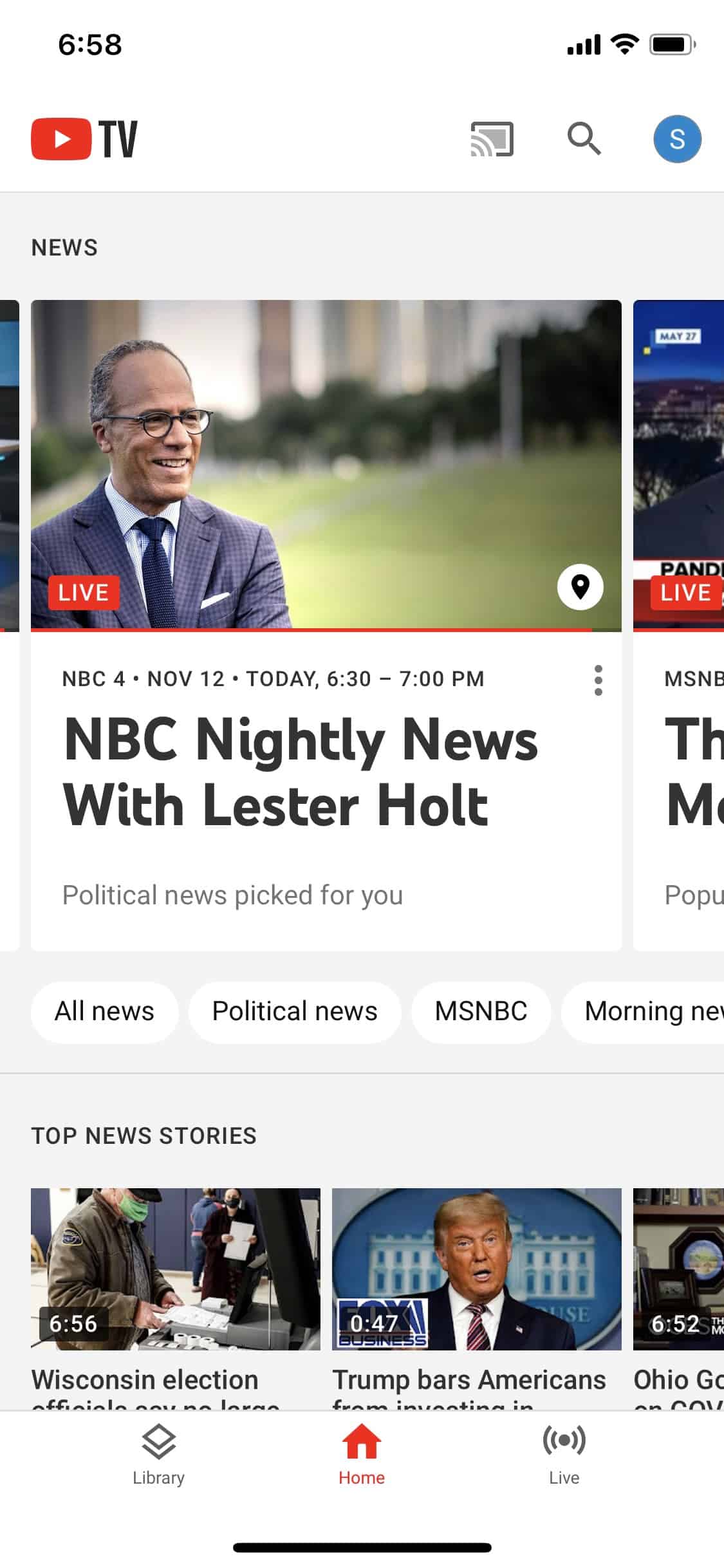
YouTube TV Platform Support
I can remember a time not so long ago when YouTube TV seemed like it would never arrive on platforms like Fire TV. Thankfully, Google has managed to work some things out with tech rivals like Amazon and Apple, and YouTube TV is now available on every major streaming platform — even Amazon’s Fire TV and Apple’s Apple TV (tvOS).
I’d pit YouTube TV’s platform support against that of any competitor service. Like its biggest rivals, YouTube TV works on all of the platforms and devices we’d recommend, including our two favorites: Roku and Fire TV. This doesn’t necessarily set YouTube TV apart from the competition, but this at least means it keeps pace. I’m giving YouTube TV full marks here.
YouTube TV Value
I thought that YouTube TV’s channel selection was really strong, but that doesn’t automatically make YouTube TV a fantastic value. Philo, for example, is missing a ton of the sports and news channels that YouTube TV has, but it still offers great value because it’s just so darn cheap. YouTube TV has all of these channels, but it’s not exactly cheap.
YouTube TV costs $64.99 per month for the first three months, then the price increases to $72.99 per month. That gets you all of the channels in the main bundle, and you can choose to pay more if you want to snag add-ons like HBO.
This isn’t a bad deal. In fact, it’s right in line with the prices I’ve seen from fuboTV and Hulu + Live TV most recently (I say “most recently” because prices can change — usually for the worse, I’m afraid). Since YouTube TV’s channel selection looks better to me than fuboTV’s, I’m inclined to say it offers a slightly better value at the same basic price (generally speaking, anyway; fuboTV pulls ahead if you’re craving certain RSNs or more interesting add-on options). YouTube TV’s value doesn’t quite measure up to Philo’s or Sling TV’s, though, since those services are so lean and cheap (though here, again, it matters what you’re after; if you want certain types of channels, like the four major networks, then these cheaper options aren’t good options at all).

YouTube TV’s plans and pricing are pretty straightforward: There’s just one main plan, take it or leave it. There are a few add-ons to consider, but the main subscription plan doesn’t change.
YouTube TV Review: Our Verdict
YouTube TV was an easy service for me to review. It’s a straightforward live TV streaming service, so it’s easy to see what it’s trying to do and which services are its competitors. It’s also easy to see where YouTube TV has the competition beat — though it’s also pretty easy to identify where it’s weaker.
YouTube TV costs about the same amount as some of its most direct competitors, but it offers arguably the most comprehensive channel selection available for that price — with the significant exception of RSN coverage. YouTube TV also offers 1080p streaming, which really helps set it apart from the competition.
But YouTube TV also stumbles at times. Its sudden loading-screen interruptions, however rare and however short, were frustrating to me. In my trials, YouTube TV seemed to stream on longer delays than I’ve grown used to seeing from competitors like Sling TV. The lack of certain RSNs might be a deal breaker for you too.
Put it all together, and I think you have a flawed but extremely exciting service. YouTube TV accomplishes what most live TV streaming services aim to: It effectively replaces cable at a lower price. I can think of a lot of specific sorts of TV fans who might find fuboTV, Philo, or Sling TV to be a better deal for their particular interests, but for a typical live TV viewer, I’d say that YouTube TV is one of the best and most straightforward cable replacements out there.

Youtube TV sucks. ZERO live support, app doesn’t work properly, etc. Set up was a nightmare. FUBO is way better.